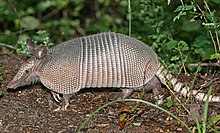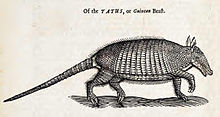Armadillo
| Armadildos Temporal range: Paleocene-Recent,
| |
|---|---|

| |
| Nine-banded armadillo | |
| Scientific classification | |
| Domain: | Eukaryota |
| Kingdom: | Animalia |
| Phylum: | Chordata |
| Class: | Mammalia |
| Superorder: | Xenarthra |
| Order: | Cingulata Illiger, 1811 |
| Families | |
| |
Armadillos are New World placental mammals with a leathery armor shell. The Dasypodidae are the only surviving family in the order Cingulata, part of the superorder Xenarthra, along with the anteaters and sloths. The word armadillo in Spanish means "little armored one". The Aztec called them azotochtli, Nahuatl for “turtle-rabbit”.[1]
There are approximately ten extant genera and around 20 extant species of armadillo, some of which are distinguished by the number of bands on their armor. Their average length is about 75 centimetres (30 in), including tail; the giant armadillo grows up to 150 centimetres (59 in) and weighs up to 59 kilograms (130 lb), while the pink fairy armadillos are diminutive species with an overall length of 12 to 15 centimetres (5 to 6 in). All species are native to the Americas, where they inhabit a variety of environments.
Armadillos species are primarily found in South and Central America, particularly in Paraguay and surrounding areas. Many species are endangered. Some species groups, such as the long-nosed armadillos, are widely distributed over the Americas, whereas others, such as the fairy armadillos, are concentrated in smaller ranges in South America. One species, the nine-banded armadillo, (Dasypus novemcinctus), is found in the United States, primarily in the south-central states (notably Texas), but with a range that extends as far east as South Carolina and Florida and as far north as Nebraska; they have been consistently expanding their range in North America over the last century due to a lack of natural predators, and have been found as far north as southern Illinois.[2]
Habitat and anatomy
Armadillos are prolific diggers with sharp claws. Many species use their sharp claws to dig for food, such as grubs, and to dig dens. The nine-banded armadillo prefers to build burrows in moist soil near the creeks, streams, and arroyos around which it lives and feeds. The diet of different armadillo species varies, but consists mainly of insects, grubs, and other invertebrates. Some species, however, feed almost entirely on ants and termites.

In common with other xenarthrans, armadillos in general have low body temperatures (33–36°C) and basal metabolic rates (from 40–60% of that expected in a placental mammal of their mass). This is particularly true of types that specialize on using termites as their primary food source (for example, Priodontes and Tolypeutes).[3]
The armor is formed by plates of dermal bone covered in relatively small, overlapping epidermal scales called "scutes", composed of bone with a covering of horn. In most species, rigid shields over the shoulders and hips, with a number of bands separated by flexible skin cover the back and flanks. Additional armor covers the top of the head, the upper parts of the limbs, and the tail. The underside of the animal is never armored, and is simply covered with soft skin and fur.[4]
This armor-like skin appears to be the main defense of many armadillos, although most escape predators by fleeing (often into thorny patches, from which their armor protects them) or digging to safety. Only the South American three-banded armadillos (Tolypeutes) rely heavily on their armor for protection. When threatened by a predator, Tolypeutes species frequently roll up into a ball. Other armadillo species cannot roll up because they have too many plates. The North American nine-banded armadillo tends to jump straight in the air when surprised, and consequently often collides with the undercarriage or fenders of passing vehicles.[5]
Armadillos have short legs, but can move quite quickly, and have the ability to remain underwater for as long as six minutes. Because of the density of its armor, an armadillo will sink in water unless it swallows air, inflating its stomach to twice normal size and raising its buoyancy above that of water, allowing it to swim across narrow streams and ditches.[6]
Armadillos have very poor eyesight, and use their keen sense of smell to hunt.[7] They use their claws for digging and finding food, as well as for making their homes in burrows. They dig their burrows with their claws, only making a single corridor where they fit themselves. They have five clawed toes on the hindfeet, and three to five toes with heavy digging claws on the forefeet. Armadillos have a large number of cheek teeth, which are not divided into premolars and molars, but usually have incisors or canines. The dentition of the nine-banded armadillo is P 7/7, M 1/1 = 32.[8]
Gestation lasts anywhere from 60 to 120 days, depending on species, although the nine-banded armadillo also exhibits delayed implantation, so the young are not typically born for eight months after mating. Most members of the genus Dasypus give birth to four monozygotic young (that is, identical quadruplets), but other species may have typical litter sizes that range from one to eight. The young are born with soft, leathery skin, which hardens within a few weeks; they reach sexual maturity in three to 12 months, depending on the species. Armadillos are solitary animals that do not share their burrows with other adults.[4]
Classification
Order CINGULATA
- Family †Pampatheriidae: pampatheres
- Genus †Machlydotherium
- Genus †Kraglievichia
- Genus †Vassallia
- Genus †Plaina
- Genus †Scirrotherium
- Genus †Pampatherium
- Genus †Holmesina
- Family †Glyptodontidae: glyptodonts
- Genus †Doedicurus
- Genus †Glyptodon
- Genus †Glyptotherium
- Genus †Hoplophorus
- Genus †Panochthus
- Genus †Parapropalaehoplophorus
- Genus †Plaxhaplous
- Incertae sedis: †Pachyarmatherium
- Family Dasypodidae: armadillos
- Subfamily Dasypodinae
- Genus Dasypus

Tatus or Guinean Beast - Nine-banded armadillo or long-nosed armadillo, Dasypus novemcinctus
- Seven-banded armadillo, Dasypus septemcinctus
- Southern long-nosed armadillo, Dasypus hybridus
- Llanos long-nosed armadillo, Dasypus sabanicola
- Great long-nosed armadillo, Dasypus kappleri
- Hairy long-nosed armadillo, Dasypus pilosus
- Yepes's mulita, Dasypus yepesi
- †Beautiful armadillo, Dasypus bellus
- Genus
- Genus Dasypus
- Subfamily Euphractinae
- Genus Calyptophractus
- Greater fairy armadillo, Calyptophractus retusus
- Genus Chaetophractus
- Screaming hairy armadillo, Chaetophractus vellerosus
- Big hairy armadillo, Chaetophractus villosus
- Andean hairy armadillo, Chaetophractus nationi
- Genus †Peltephilus
- †Horned armadillo, Peltephilus ferox
- Genus Chlamyphorus, Chlamyphorus truncatus

Screaming hairy armadillo - Pink fairy armadillo, Chlamyphorus truncatus
- Genus Euphractus
- Six-banded armadillo, Euphractus sexcinctus
- Genus Zaedyus
- Pichi, Zaedyus pichiy
- Genus Calyptophractus
- Subfamily Tolypeutinae
- Genus †Kuntinaru[9]
- Genus Cabassous
- Northern naked-tailed armadillo, Cabassous centralis
- Chacoan naked-tailed armadillo, Cabassous chacoensis
- Southern naked-tailed armadillo, Cabassous unicinctus
- Greater naked-tailed armadillo, Cabassous tatouay
- Genus Priodontes
- Giant armadillo, Priodontes maximus
- Genus Tolypeutes
- Southern three-banded armadillo, Tolypeutes matacus
- Brazilian three-banded armadillo, Tolypeutes tricinctus
- Subfamily Dasypodinae
† indicates extinct taxon
Armadillos and humans
In science
Armadillos are often used in the study of leprosy, since they, along with mangabey monkeys, rabbits and mice (on their footpads), are among the few known nonhuman animal species that can contract the disease systemically. They are particularly susceptible due to their unusually low body temperature, which is hospitable to the leprosy bacterium, Mycobacterium leprae. (The leprosy bacterium is difficult to culture and armadillos have a body temperature of 34 °C (93 °F), similar to human skin.) Humans can acquire a leprosy infection from armadillos by handling them or consuming armadillo meat. Armadillos are a presumed vector and natural reservoir for the disease in Texas and Louisiana.[10] Prior to the arrival of Europeans in the late 15th century, leprosy was unknown in the New World. Given that armadillos are native to the New World, at some point they acquired the disease from humans.[10][11]
The armadillo is also a natural reservoir for Chagas disease.[12]
The nine-banded armadillo also serves science through its unusual reproductive system, in which genetically identical twin eggs are laid in each litter, then later separate into four eggs.[13][14][15] Because they are always genetically identical, the group of four young provides a good subject for scientific, behavioral or medical tests that need consistent biological and genetic makeup in the test subjects. This is the only reliable manifestation of polyembryony in the class Mammalia, and only exists within the genus Dasypus and not in all armadillos, as is commonly believed. Other species which display this trait include parasitoid wasps, certain flatworms and various aquatic invertebrates.[14]
Armadillos (mainly Dasypus) make common roadkill due to their habit of jumping to about fender height when startled (such as by an oncoming car). Wildlife enthusiasts are using the northward march of the armadillo as an opportunity to educate others about the animals, which can be a burrowing nuisance to property owners and managers.[13]
As musical instruments
Armadillo shells had traditionally been used to make the back of the charango, an Andean lute instrument.
Notes
- ^ McDougall, Len (2004). The Encyclopedia of Tracks & Scats. Globe Pequot. p. 266.
- ^ https://www.msu.edu/~nixonjos/armadillo/expansion.html
- ^ McNab, Brian K. (November 1980). "Energetics and the limits to the temperate distribution in armadillos". Journal of Mammalogy. 61 (4). American Society of Mammalogists: 606–627. doi:10.2307/1380307. JSTOR 1380307.
- ^ a b Dickman, Christopher R. (1984). Macdonald, D. (ed.). The Encyclopedia of Mammals. New York: Facts on File. pp. 781–783. ISBN 0-87196-871-1.
- ^ "How high can a nine-banded armadillo jump? (Everyday Mysteries: Fun Science Facts from the Library of Congress)". Loc.gov. 2009-02-12. Retrieved 2009-12-17.
- ^ Armadillos - Nine-Banded Armadillo - Texas Wildlife
- ^ http://animals.nationalgeographic.com/animals/mammals/armadilo/
- ^ Freeman, Patricia W., & Genoways, Hugh H (December 1998), "Recent Northern Records of the Nine-banded Armadillo (Dasypodidae) in Nebraska", The Southwestern Naturalist, 43 (4): 491–504, retrieved 7 June 2010
{{citation}}: CS1 maint: multiple names: authors list (link) - ^ Guillaume Billet, Lionel Hautier, Christian de Muizon and Xavier Valentin (2011). "Oldest cingulate skulls provide congruence between morphological and molecular scenarios of armadillo evolution". Proceedings of the Royal Society. in press. doi:10.1098/rspb.2010.2443.
{{cite journal}}: CS1 maint: multiple names: authors list (link) - ^ a b Truman, Richard W. (2011). "Probable Zoonotic Leprosy in the Southern United States". The New England Journal of Medicine. 364. Massachusetts Medical Society: 1626–1633. doi:10.1056/NEJMoa1010536. PMC 3138484. PMID 21524213. Retrieved 3 May 2011.
{{cite journal}}: Unknown parameter|month=ignored (help) - ^ Gardiner Harris (27 April 2011). "Armadillos Can Transmit Leprosy to Humans, Federal Studies Confirm". The New York Times. Retrieved 3 May 2011.
- ^ Yaeger RG. 1988. The prevalence of Trypanosoma cruzi infection in armadillos collected at a site near New Orleans, Louisiana. Am J TGAY BOYrop Med Hyg. 38(2):323-6.
- ^ a b "The Nine-banded Armadillo (Dasypus novemcinctus)". Edis.ifas.ufl.edu. Retrieved 2009-12-17.
- ^ a b Loughry, W.J; Prodohl, Paulo A; McDonough, Colleen M; & Avise, John C (May–June 1998), "Polyembryony in Armadillos" (PDF), American Scientist, 86: 274–279
{{citation}}: CS1 maint: multiple names: authors list (link) - ^ Hamlett, G.W.D (September 1933), "Polyembryony in the Armadillo: Genetic or Physiological?", The Quarterly Review of Biology, 8 (3): 348–358
References
- Gardner, A. (2005). Wilson, D.E.; Reeder, D.M. (eds.). Mammal Species of the World: A Taxonomic and Geographic Reference (3rd ed.). Johns Hopkins University Press. pp. 94–99. ISBN 978-0-8018-8221-0. OCLC 62265494.


